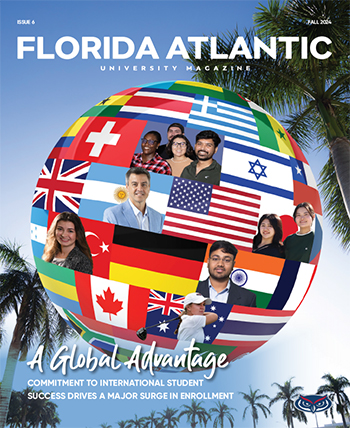1/2/2025
Florida Atlantic: The Stinky Seaweed Struggle
$1M Grant to Help Battle Blooms
The emergence of a massive expanse of seaweed, known as the Great Atlantic Sargassum Belt, has wreaked havoc on ecosystems and economies throughout Florida, the Gulf of Mexico and the Caribbean in the past decade. Conversely, this stinky brown seaweed also provides vital habitats for marine life, including loggerhead sea turtles.
As a major Florida attraction, clean and healthy beaches are imperative for the state’s tourist-based economy. But eliminating vast piles of seaweed on the shores every year while protecting these critical habitats proves a precarious struggle.
Decomposing Sargassum produces hydrogen sulfide and ammonia, which can result in potential human and environmental health impacts. Once it deluges beaches, removing, disposing and repurposing the seaweed also presents many logistical and economic challenges. This causes problems to arise when it isn’t cleaned up in a timely manner.
To address this challenge, Florida Atlantic University Harbor Branch Oceanographic Institute researchers received a $1.3 million grant from the Florida Department of Emergency Management for a project to assess the feasibility of in-water harvesting of this floating brown seaweed in Florida. They also are examining both environmental and ecological impacts of Sargassum inundations in the state.
"Sargassum is becoming a devasting mainstay in parts of Florida’s coastal communities, particularly in the Florida Keys, where massive blooms continue to recur," said Brian Lapointe, Ph.D., principal investigator and research professor at FAU Harbor Branch. "Economically, a ‘severe’ Sargassum event could have more than a $20 million impact in just the Keys alone. Environmentally, these blooms can potentially harm humans, exacerbate eutrophication resulting in die-offs of seagrasses and corals, and kill recreational and commercially important species."
As part of the project, Lapointe and his team are using drones, GoPros and other remote vehicles to survey Sargassum sites above water, measuring mat sizes and collecting high-resolution aerial images. They also are examining changes in beach structure, as well as Sargassum thickness and biomass per square meter. Additionally, they are conducting a trial removal using dip nets to explore harvesting methods that minimize harm to marine life, under permits from agencies like the Florida Fish and Wildlife Commission and National Oceanic and Atmospheric Administration.
Due to the expanding size and duration of blooms in the Great Atlantic Sargassum Belt, regions are investigating new ways to utilize excess Sargassum biomass for economic ventures like biofuels and bioplastics. Addressing concerns over arsenic content, the FAU Harbor Branch researchers are studying how arsenic accumulates in Sargassum through field samples and lab experiments to better understand its implications for potential industrial uses.
To gain insight into the impacts of Sargassum inundations on water quality, the researchers also are measuring pH, dissolved oxygen, temperature, dissolved nutrients and fecal indicator bacteria in inundation sites.
"Data from this timely research will help to inform managers whether it is better to harvest Sargassum in water as opposed to on the beach and help them better plan for removing vast amounts of seaweed from our beaches and preventing aggregations," said James M. Sullivan, Ph.D., executive director of FAU Harbor Branch.
For more information, email dorcommunications@fau.edu to connect with the Research Communication team.

